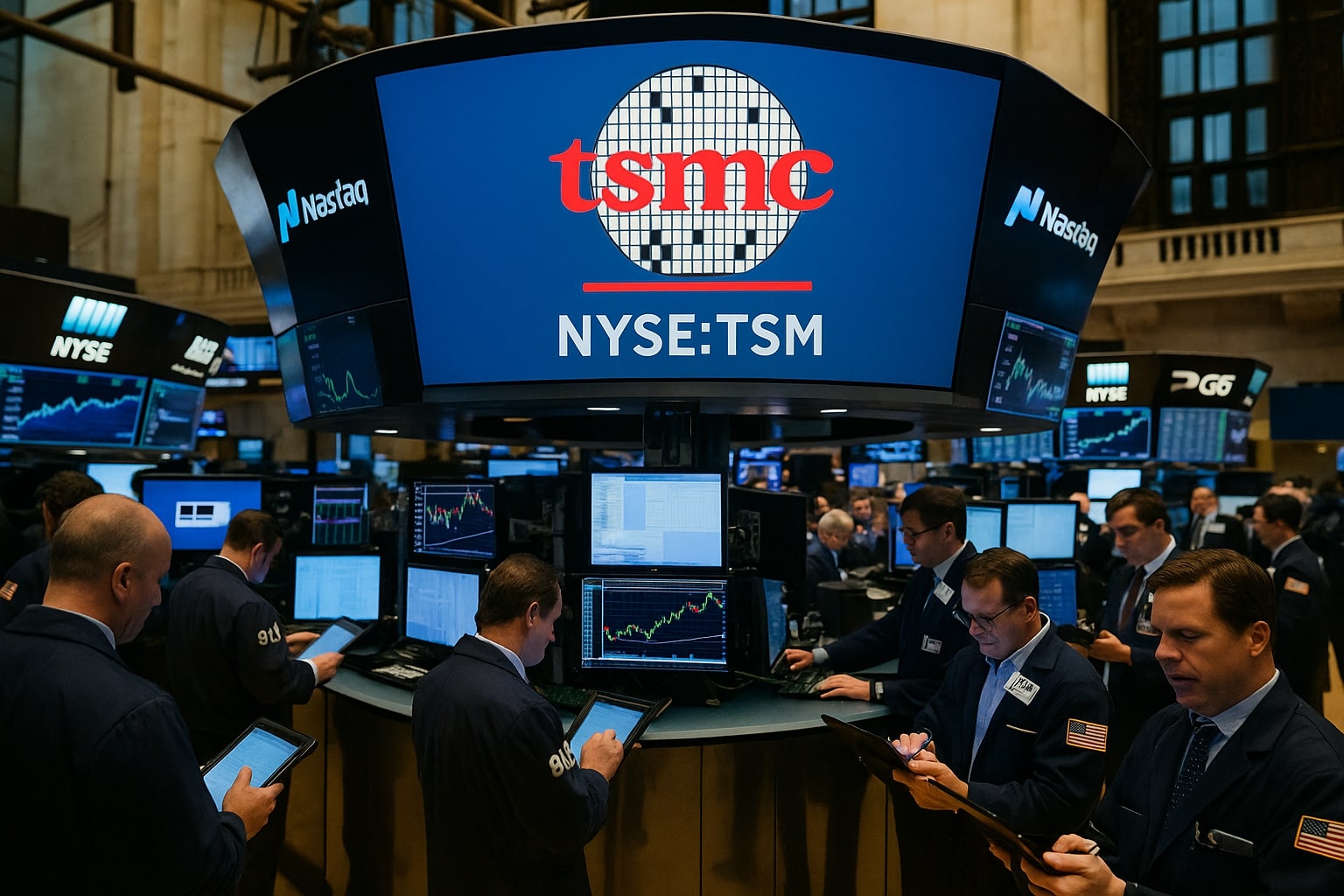NYSE:TSM Faces Export Curbs While Advanced Node Growth Drives Long-Term Upside
Taiwan Semiconductor Manufacturing Company (NYSE:TSM) is trading around $226.72, down nearly 1.9% on the day, after Washington revoked its fast-track Validated End User (VEU) export authorization for its Nanjing plant. Effective December 31, 2025, every shipment of U.S.-controlled chipmaking equipment to China will require individual licensing, creating the risk of supply bottlenecks and production delays. The Nanjing site, which has operated on 16nm processes since 2018, represents a modest 7% of total revenue, but the removal of blanket export privileges introduces administrative hurdles and uncertainty. More than 1,000 new license applications annually are now expected, potentially slowing equipment deliveries and straining TSMC’s ability to maintain uninterrupted operations in China. The U.S. Commerce Department has pledged to approve licenses that ensure continuity, but it has made clear no expansions or technology upgrades will be permitted under this framework.
AI Chip Demand Anchors Revenue Growth for NYSE:TSM
Even as export risks cloud its China operations, TSMC’s growth engine remains tied to AI and HPC chips, which now account for a majority of revenues. Management projects AI-related sales to grow at a 45% CAGR over the next five years, with total revenue expanding near 20% CAGR. Nvidia alone could represent over 20% of TSMC’s revenue in 2025, translating to more than $24 billion in sales. Reuters reported Nvidia may ship a China-compliant B30/B30A Blackwell GPU as early as September, a product still expected to run on TSMC’s 4NP nodes and advanced CoWoS packaging. If this line gains approval, it could unlock $23.8 billion in incremental AI-related demand from China, effectively mirroring TSMC’s entire current annual intake from Nvidia. With packaging capacity already constrained, higher average selling prices on advanced CoWoS and HBM integrations would further lift margins despite rising costs abroad.
Advanced Node Dominance and Technology Roadmap
TSMC continues to lead in advanced nodes, with 69% of 2024 revenues derived from processes under 7nm. Its 3nm ramp now accounts for an increasing share, while 7nm contributions are tapering. Competitors remain far behind: Samsung has struggled with yields below 50% and has delayed its 1.4nm plans into 2028 or later, while Intel’s 18A and 14A projects face further postponements to 2026. By contrast, TSMC is on track to scale 2nm production in late 2025, followed by nodes below 2nm through 2026. Its technology roadmap underpins its ability to retain major partners like Apple, Nvidia, AMD, Broadcom, Marvell, Microsoft, Google, and Amazon AWS, all of which rely on TSMC’s foundry services for next-generation chips. This moat has allowed TSMC to capture 64.3% global foundry market share in 2024, widening its lead over Samsung and dwarfing GlobalFoundries, UMC, and SMIC.
CapEx Expansion and U.S. Fabs Add Margin Pressure
The company is in the midst of its largest overseas buildout. Its Arizona Fab 21 project spans three phases at a total investment of $65 billion, with 4nm wafers already shipping and 3nm capacity coming online next year. A third facility for 2nm and below is targeted for 2028, with Arizona expected to host 30% of TSMC’s 2nm capacity once mature. In Japan, Kumamoto Fab 1 launched in late 2024 with 55,000 wpm capacity, while Fab 2 construction begins in 2025 aiming for 100,000 wpm. These expansions are strategically vital for U.S. customer proximity and tariff exemptions, but margins face 210 basis point dilution in Q3 2025 and could be pressured by 2–3% annually through the decade. Arizona labor costs are particularly steep, with technician salaries between $50,000–$77,000 annually compared to $13,000 in Taiwan, driving 10–20% higher wafer costs. Management believes premium pricing for advanced nodes offsets this, but investors should expect gross margins to remain capped below 60% in the medium term.
Financial Performance and Valuation Metrics
For the twelve months ending June 30, 2025, TSMC generated NT$3.4 trillion ($106 billion) in revenue, up 38.6% year-over-year, with net income surging 60.7% to NT$1.29 trillion ($40.2 billion). Gross margins held near 56.5%, while operating margin reached 49.6%, among the highest in the sector. Diluted EPS for the trailing year was $9.10, and forward estimates call for $9.75 in FY25 rising to $11.10 in FY26. Shares trade at a 24.9x trailing P/E and 23.7x forward P/E, only a modest premium to the broader market despite structurally higher growth. On an EV/EBITDA basis, TSMC trades at 11.5x, below its historical peaks and sector medians. With consensus revenue projected to reach NT$4.21 trillion ($132 billion) in 2026, representing 15.5% growth, fair value estimates cluster around $269–$300 per share, with Barclays, Needham, and Susquehanna all reiterating bullish ratings.
Dividend Policy and Capital Returns
TSMC has steadily increased dividends, with the forward annual payout now $3.34 per share, representing a 1.45% yield. The payout ratio is a disciplined 30.5%, leaving ample room for reinvestment in CapEx-heavy expansion while rewarding shareholders. The stock has gained 43.8% over the past year, outpacing the S&P 500’s 16.8% rise. With its 52-week range between $134.25 and $248.28, current levels around $226.72 place it mid-range but below analyst targets.
Tariffs, Geopolitics, and Risk Factors
While the revocation of export waivers is headline risk, the practical revenue exposure to mainland China remains only 7%, and TSMC is already pivoting away from Chinese equipment in its most advanced 2nm nodes. Trump’s tariff plans include a 100% levy on imported semiconductors, but exemptions for companies expanding U.S. production, including TSMC’s Arizona fabs, should shield the company. Automotive remains a minor drag, with only 5% revenue exposure to the sector, and estimated tariff-related losses of just 0.075% of total sales. The real risk lies in execution on overseas fabs and packaging bottlenecks. With CoWoS capacity fully booked and constrained, management is racing to expand supply to meet hyperscaler demand.
Insider Transactions and Institutional Positioning
For detailed records of insider activity, investors can track every disclosed transaction on the insider transactions page. The company also maintains a full stock profile for financial and governance disclosures. Institutional ownership is currently 16.4%, with insider holdings minimal at 0.04%, reflecting the state-controlled structure and heavy retail participation in Taiwan. Short interest remains negligible at 0.49% of float, underscoring strong conviction among long-term holders.
Buy, Sell, or Hold on NYSE:TSM
At $226.72, NYSE:TSM is trading at an attractive multiple relative to its growth trajectory. The company is uniquely positioned as the global leader in advanced nodes, with AI demand set to deliver 20% CAGR revenue expansion, even as export restrictions and high-cost U.S. fabs temper margin growth. With analyst targets clustered between $269–$306, and long-term upside fueled by AI adoption and 2nm ramp, the stock remains a clear outperformer in semiconductors.
Verdict: Buy. Taiwan Semiconductor’s export challenges are manageable, China exposure is limited, and AI demand keeps growth intact. Investors should view current weakness as an entry point ahead of earnings on October 16, where continued record results are likely to reset price targets higher.



















